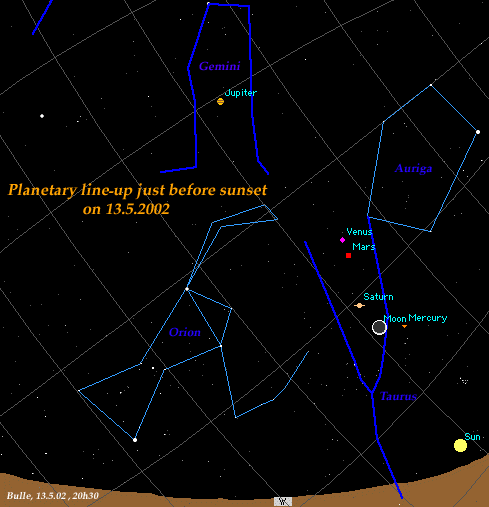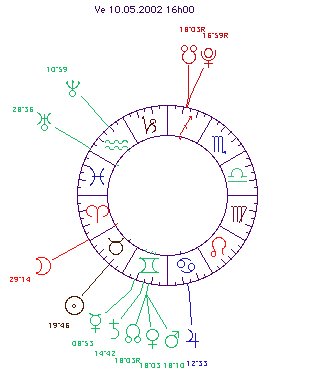
Kolisko Index A Chemical Theatre Moon-Mars Experiments Mars-Saturn Experiments Moon-Saturn Experiments Gold-Sun Experiments Experimental Procedure The Astronomy
Kolisko Experiments over Mars conjunctions - in May (Saturn & Venus) and July (Jupiter) of 2002
An account by Guy Desbiolles*
The evening sky of May 2002 allowed us to see all the traditional planets with the naked eye. (Fig1). So I also wanted to try to follow their movements with the Kolisko method. For the Mars-Saturn conjunction, 1% solutions of iron sulphate, lead nitrate and silver nitrate in deionised water were used, with ten-by-twenty centimetres Whatman No.1 filter paper, conventional Petri dishes and ambient natural light (i.e. no direct sunlight). Two ml. of each solution were mixed in the sequence given, at noon each day, then filter papers were placed in the solutions and left to stand for 50 minutes, then hung up to dry and photographed using an overhead projector in ambient light. The same iron solution was used over the ten days of the experiment, stirred before each pipetting.

Fig. 1
The experiments were conducted in a chemistry laboratory, in the small city of Bulle, Switzerland (There are a group of mobile phone antennas in the vicinity, but experiments conducted in a Faraday cage gave the same results as the others).
Results: The images on the 3rd and 4th of May showed a vanishing of form (Fig. 2), replaced by a heavy darkness: the usual 3D- looking details were lacking. As the celestial conjunction was in the early morning of the 4th , this seemed in accord with Kolisko's theory. The effect began two days before the event, and by two days after the conjunction the images were back to 'normal'. The overall aspect of the obtained images is different from the ones of 1990 in the sense that there are no 'big' structures associated with the metal formation, yet the conjunction of Mars and Saturn on the 4th of May is clearly visible. The images gradually become less well-formed as the iron solution grows older.

Fig. 2
Mars-Venus conjunction of May 10th
Since another conjunction of Mars and Venus exactly on the north node of the Moon followed
soon after, I decided to continue the daily noon experiments using the normal iron, lead
and silver solutions. The forms again faded out on the 9th/10th during this event (Mars
conjunct Venus), as can be seen in Figure 3.

Fig. 3
Pluto, Saturn and the node were also involved in this configuration as can be seen in fig 4.

Fig. 4
In addition, I made parallel experiments using copper instead of lead: 2 ml. of 1% of iron sulphate, copper sulphate and silver nitrate mixed in that order, with otherwise the same conditions as mentioned above. The meeting of Mars and Venus was visible in the filterpapers, though perhaps less impressively than for the Mars-Saturn event (Fig. 5). On the day of the conjunction, all of the '3-D' type forms had gone, then they came back on the following days. The global aspect is much smoother and lighter using copper (Fig 5) rather than lead (Fig. 4), the ambience is harmonious: the copper-Venus effect.

Fig. 5
Mars-Jupiter conjunction of July 3rd 2002
The solutions used are 1% iron II sulphate, tin II sulphate, and silver nitrate mixed in
that order. The same solutions were used for all the experiments, simply well stirred
before use since there is a precipitate both in the tin and iron solutions after only one
day. The preliminary tests with the new and old solutions at the same time have shown that
the global aspect is very similar, the effect is simply weaker with the old solutions. The
other conditions are the same as the other experiments with lead and copper.
The fading of the structures is the “normal “ effect though spread over a longer period i.e seven days centered on the day of the conjunction.

Fig. 6 (reverse-colour, to show off certain features of the sequence)
At the same time the images show much more variations in their global aspect as the other ones. It is dynamic and changing: the Mars-Jupiter effect.

Fig. 7
The author had previously performed a comparable experiment, during the Mars-Saturn conjunction of March 1990. A colleague of his who was sceptical about alchemy, etc. agreed to witness it, and agreed that 'on the day of the experiment the typical figures almost completely disappeared' (in a manner that was similar to the effect during the Weleda experiment of 1949). His colleague declined, however, to accept an explanation in terms of a meeting of planets.
Summarising, Guy Desbiolles conducted a 25-day experiment April 26 - May 21st, centred on a Mars-Saturn conjunction. Then, he began another sequence adding a copper salt to the mixture, to study the meeting of Mars with Venus, during the 13 days May 7th - 20th. Finally, as Mars and Jupiter met in the sky on July 3rd, he did one more trial over the 25 days June 19th - July 9th. For these three experiments he made respectively about 50, 25 and 50 filterpaper-pictures. Colleagues at G.D.'s chemistry lab. inspected his procedure and results - some skeptical, others not.
*Guy Desbiolles graduated in chemistry at the university of Fribourg and teaches chemistry in Switzerland. guydesbiolles@bluewin.ch
The author can supply quality photoprints, (E-mail your wishes as to individual or group images, size etc...)
Kolisko Index A Chemical Theatre Moon-Mars Experiments Mars-Saturn Experiments Moon-Saturn Experiments Gold-Sun Experiments Experimental Procedure The Astronomy